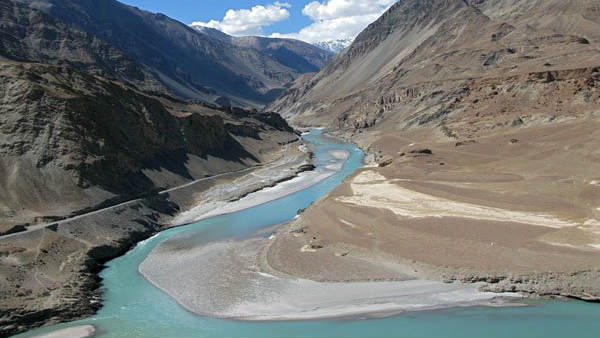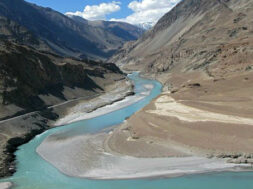
Manas Dasgupta
NEW DELHI, Jan 27: In a significant development, India has cited Pakistan’s persistent objections regarding Kishenganga and Ratle hydropower projects in Kashmir and issued a notice to Islamabad for modification of the Indus Waters Treaty (IWT) of September, 1960, following Pakistani “intransigence” on its implementation, sources said on Friday.
The notice sent to Pakistan through Commissioners for Indus Waters on January 25, will open the process of making changes to the treaty, the sources said. They said that the notice for modification was to provide Pakistan with an opportunity to enter into intergovernmental negotiations within 90 days to rectify the material breach of IWT. “This process would also update the IWT to incorporate the lessons learned over the last 62 years,” sources said.
India has issued the notice to Pakistan under Article XII (3) of the IWT. “The provisions of this Treaty may from time to time be modified by a duly ratified treaty concluded for that purpose between the two Governments,” this provision states.
The action was necessitated as Pakistan has refused to discuss and resolve the issue of India’s Kishenganga and Ratle Hydro Electric Projects for the last five years, despite India’s efforts, sources said.
“India has always been a steadfast supporter and a responsible partner in implementing IWT in letter and spirit. However, Pakistan’s actions have adversely impinged on the provisions of IWT and their implementation, and forced India to issue an appropriate notice for modification of IWT,” sources said.
Pakistan had in 2015 sought a neutral expert to examine its technical objections to India’s Kishenganga and Ratle Hydro Electric Projects. However, it withdrew the next year unilaterally and proposed that a Court of Arbitration adjudicate its objections. Two simultaneous processes are in contravention of the graded mechanism of dispute settlement, sources said, adding that India then made a separate request for the matter to be referred to a neutral expert.
“The initiation of two simultaneous processes on the same questions and the potential of their inconsistent or contradictory outcomes creates an unprecedented and legally untenable situation, which risks endangering IWT itself. The World Bank acknowledged this itself in 2016, and took a decision to “pause” the initiation of two parallel processes and request India and Pakistan to seek an amicable way out,” sources said.
The Indian side has alleged that by unilaterally changing the request from seeking a “Neutral Expert” to a “Court of Arbitration”, Pakistan has violated the Indus Waters Treaty which has been further complicated by the World Bank recently moving to act on both Neutral Expert and Court of Arbitration. “Such parallel considerations on the same issues is not covered under any provision of IWT,” said the source. “Faced with such violation of IWT provisions, India has been compelled to issue notice of modification,” the sources said.
Government sources said despite repeated efforts by India to find a mutually agreeable way forward, Pakistan refused to discuss the issue during the five meetings of the Permanent Indus Commission from 2017 to 2022. At Pakistan’s continuing insistence, the World Bank has recently initiated actions on both the neutral expert and Court of Arbitration processes, they said.
It was argued that a dispute in the IWT has been brewing since 2015 when Pakistan asked for the appointment of a “Neutral Expert” to probe its “technical objections” to India’s Kishenganga and Ratle Hydro Electricity Projects. In 2016, Pakistan changed that request and proposed that a Court of Arbitration should examine the objections. In response, India sought the appointment of a Neutral Expert. Sources said that the two processes would be contradictory and be “legally untenable.”
The IWT was signed on September 19, 1960, by Prime Minister Jawaharlal Nehru and Pakistan president Mohammad Ayub Khan in Karachi after nine years of World Bank-brokered negotiations between India and Pakistan. The treaty defines the water-sharing arrangement for six rivers of the Indus basin that flow through both India and Pakistan.
As per the treaty’s provisions, India can make “unrestricted use” of all the water of the “Eastern Rivers” — Sutlej, Beas, and Ravi — while Pakistan shall get water from the “Western Rivers”, Indus, Jhelum, and Chenab.
All the waters of the Eastern Rivers shall be available for the unrestricted use of India, except as otherwise expressly provided in this Article,” states Article II (1) of the treaty.
The Article III (1), which has provisions related to the Western Rivers, states, “Pakistan shall receive for unrestricted use all those waters of the Western Rivers which India is under obligation to let flow under the provisions of Paragraph (2).” Despite periodic suggestions in India about scrapping the IWT given Pakistan’s continued support to terrorism against India, the treaty has been a durable document that has survived three wars and decades of tensions.
The dispute raised by Pakistan since 2015 was that India is constructing two hydroelectric power projects (HEPs) —on the Kishenganga, a tributary of the Jhelum — and the Ratle HEP on the Chenab. Pakistan has objected to these projects.
In October, last year, the World Bank named Michel Lino as the Neutral Expert and Prof Sean Murphy as Chairman of the Court of Arbitration. “They will carry out their duties in their individual capacity as subject matter experts and independently of any other appointments they may currently hold,” the Bank said in a statement on October 17, 2022.
The Kishenganga project is located in village Kralpora on the Kishenganga River in Bandipora district of the Union Territory of Jammu & Kashmir. The project site is about 70 km from Srinagar and 370 km from Jammu. The project was inaugurated by Prime Minister Narendra Modi in May 2018.
The project has a “horseshoe/circular shaped”, “concrete face rock-fill dam” of 37 m height. It is a run-of-the-river scheme that has three generation units of 110MW each, with a total capacity of 330 MW. The water of the river is diverted to the underground powerhouse through a 23.25-km-long Head Race Tunnel, to generate 1,713 million units of electricity per annum.
According to an official statement issued in 2018, the project will benefit, apart from J&K, the states of Chhattisgarh and Uttar Pradesh. “Kishenganga HE Project will provide a free power of 13 per cent to the state (erstwhile J&K), which will be around Rs 133 crore per year,” the statement said.
The Ratle Hydroelectric project is proposed on the river Chenab in Kishtwar district of Jammu & Kashmir at a location about 140 km from Udhampur and 201 km from Jammu. It is a run-of-the-river project, with a 133-m-high concrete dam.
The project, with a capacity of 850 MW, will have five generation units — four units of 205 MW each and one unit of 30 MW. Once fully operational, the project can generate 3,136.76 million units of energy annually. The project cost is pegged at Rs 5,281.94 crore (November 2018 prices).
The project will be implemented by a new joint venture company (JVC) to be incorporated between NHPC and Jammu & Kashmir State Power Development Corporation Ltd (JKSPDC) with equity contribution of 51% and 49% respectively.













